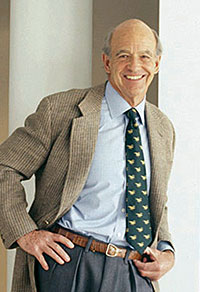Books |
Charles Gwathmey (1938-2009)

By
Published: Aug 05, 2009
Category:
Art and Photography
A man I love died the other day, and like a lot of people who knew Charles Gwathmey, I’m having trouble using the past tense about him. Charles was 71 — “a young man, “ my mother would say. Ill? Maybe. But the last time I saw him, just weeks ago, he looked great. Dead? Not possible.
Gwathmey, partner of Robert Siegel in one of the planet’s most highly regarded architectural firms, was an artist of great gifts, bred-in-the-bone integrity and celebrity clients from the A+ list — Geffen, Spielberg, Katzenberg and Eisner. So add toughness and patience to the list of his gifts, because those gents are fierce. One wanted a swimming pool at least an inch longer than another client’s. One measured the spaces between concrete squares on a long path to make sure they were all the same. Typically, the clients told me those stories — Charlie didn’t gossip.
How tough was Charles Gwathmey? A few years ago, he had a lung removed. No biggie: “I am the only person of my age, in the Memorial Hospital history, who has gone without a lung and fully recovered. Because of exercise, the other lung has expanded and filled the cavity.” Okay, maybe he exaggerated. But you can read in those lines the immense pride he took in being Exactly Right. Making the Best Dressed List wasn’t vanity for him, it was just another way of spacing the squares correctly, getting the fullest possible breath, doing immaculate work.
His buildings were, in the main, strong, clean, elemental. He defined good architecture as “reductive, abstract and lacking of any ornamentation,” so he had a style that was immediately recognizable. But the houses weren’t cookie-cutter; in each, he addressed, and solved, a technical problem. I interviewed him a few times, and his explanations of his design choices were dizzyingly intellectual. [Here’s a sample of his thinking, in this case about a library addition at Yale.] At the core, though, Charlie was quite clear: He was committed to the “irrefutably articulate, primary and memorable” quality of “the rotated square overlaid on the circle”, and the changes he rang on that idea put him in the pantheon of Modernist architecture.
He’s in my pantheon as a friend. We met in the mid-eighties, when I was coming out of one marriage and into another. Charlie and Bette-Ann had been there, and I gravitated to them, because they so obviously had figured out a way to ride the waves of divorce and blended family. And they were deftly — that is, openly, unashamedly — handling tragedy: the recent death from cancer of 18-year Robbie Steel, one of Bette-Ann’s three children.
Two years after Robbie died, Bette-Ann’s daughter, Courtney Steel — 17-year old president of her class at Spence, bound for Harvard — went out to a bar with friends. At 3 AM, as she was crossing the street, a young, drunk mortgage banker came speeding along. His car hit Courtney with so much force she was lifted onto the hood. But he never even tapped the brakes.
I’ve been to my share of funerals, but Courtney Steel’s — whatever you imagine, it was worse. I had the feeling I needed to do more than send a note. Then I read the letter that Eric Steel, Bette-Ann’s sole surviving child, wrote to the judge. And I knew: This story was mine.
The reporting for the piece I wrote for Vanity Fair was extremely difficult. Not that the Gwathmeys held anything back — Bette-Ann used our conversations, as I’m sure she used many others, as safe places to grieve. But the Gwathmeys had certain expectations for the piece, and as I was a friend, they assumed I would honor them — namely, that I would demonize the killer.
What kind of man kills someone and drives on? I went to visit the killer’s family to find out. His parents’ stories were evasions, their explanations limp. But they gave me what the piece needed: a portrait of denial.
Before the piece was published, I didn’t tell the Gwathmeys what I’d learned. It didn’t matter. Charlie began calling me at night to berate me for offering the killer’s story in any way. He was blunt and loud; if he had shouted to my apartment, just across Central Park from his home, I could have heard him. After a while, I stopped answering the phone at night — he was that persistent. The piece appeared. With predictable effect: horror for the Gwathmeys, revulsion at the killer and his family.
We invited Charles and Bette-Ann to a party. My stepson, then no more than four, saw Charlie’s bald head and went right for him. A minute later, he was on Charlie’s lap, having his hair mussed and getting a lesson in the proper alignment of Legos. My wife and I had to look away.
“No man can look long at the sun or death,” Le Rochefoucauld said. So it was with the Gwathmeys. For the last two decades, whenever I saw Charlie, we became two guys bantering, jabbing, tossing in a compliment only as a surprise weapon. Tough love — it seemed like a kindness.
I so wish I could do him another.
For a brief sketch of Charles Gwathmey’s career, click here.
To buy “Gwathmey Siegel: Buildings and Projects 1965-2000” from Amazon.com, click here.

